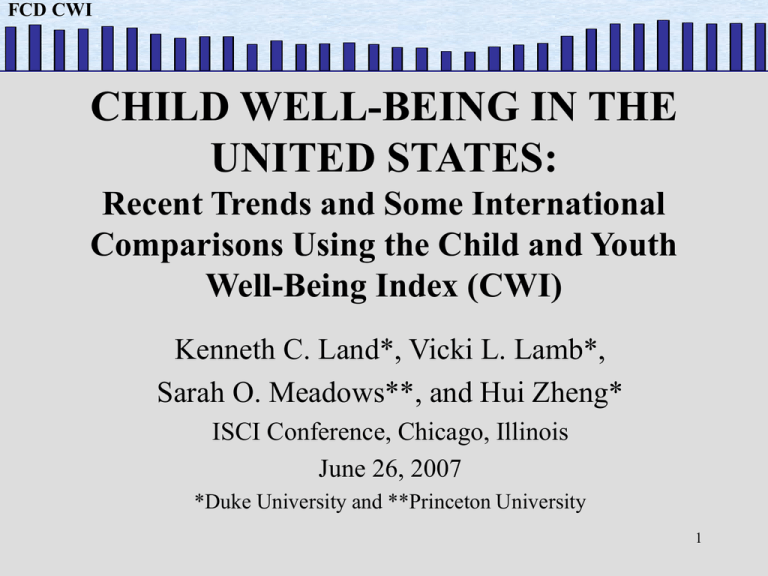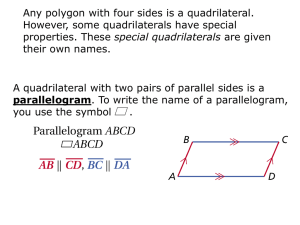
FCD CWI
FCD
CWI
CHILD WELL-BEING IN THE
UNITED STATES:
Recent Trends and Some International
Comparisons Using the Child and Youth
Well-Being Index (CWI)
Kenneth C. Land*, Vicki L. Lamb*,
Sarah O. Meadows**, and Hui Zheng*
ISCI Conference, Chicago, Illinois
June 26, 2007
*Duke University and **Princeton University
1
FCD CWI
FCD
CWI
The Basic Social Indicators Questions
• How are we doing?
• More specifically, with respect to
children, how are our kids
(including adolescents and youths)
doing?
2
FCD CWI
FCD
CWI
The Basic Social Indicators Questions
These questions can be addressed by
comparisons:
to goals or other externally established standards,
to past historical values, or
to other contemporaneous units (e.g., comparisons
among subpopulations, states, regions, countries).
The CWI uses all three points of comparison.
3
FCD CWI
FCD
CWI
Three Publications on the CWI
• Land, Kenneth C. Vicki L. Lamb, and Sarah Kahler
Mustillo 2001 “Child and Youth Well-Being in the United
States, 1975-1998: Some Findings from a New Index,”
Social Indicators Research, 56, (December):241-320.
• Land, Kenneth C. Vicki L. Lamb, Sarah O. Meadows, and
Ashley Taylor 2007 “Measuring Trends in Child WellBeing: An Evidence-Based Approach,” Social Indicators
Research, 80:105-132.
• Hagerty, Michael R. and Kenneth C. Land 2007
“Constructing Summary Indices of Quality of Life: A
Model for the Effect of Heterogeneous Importance
Weights,” Sociological Methods and Research,
4
35(May):455-496.
FCD CWI
FCD
CWI
What is the CWI?
• A composite measure of trends over time in
the quality of life, or well-being, of
America’s children and young people.
• It consists of several interrelated summary
or composite indices of annual time series
of 28 social indicators of well-being.
5
FCD CWI
FCD
CWI
The Objectives of the CWI:
• To give a sense of the overall direction of
change in the well-being of children and
youth in the United States as compared to
1975.
6
FCD CWI
FCD
CWI
The CWI is designed to address the
following types of questions:
• Overall, on average, how did child and youth
well-being in the United States change in the
last quarter of the 20th century and into the
present?
• Did it improve or deteriorate, and by how
much?
• In which domains or areas of social life?
7
FCD CWI
FCD
CWI
•
•
•
•
For specific age groups?
For particular race/ethnic groups?
For each of the sexes?
And did race/ethnic group and sex
disparities increase or decrease?
8
FCD CWI
FCD
CWI
Methods of Index Construction
• Annual time series data (from vital statistics and
sample surveys) have been assembled on some
28 national level indicators in seven quality-oflife domains:
–
–
–
–
–
–
–
Family Economic Well-Being
Health
Safety/Behavioral Concerns
Educational Attainment
Community Connectedness
Social Relationships (with Family and Peers)
Emotional/Spiritual Well-Being
9
FCD CWI
FCD
CWI
• These seven domains have been well-established
in over two decades of empirical studies of
subjective well-being, including studies of
children and youths, by social psychologists and
other social scientists.
• In this sense, the CWI is an evidence-based
measure of trends in averages of the social
conditions encountered by children and youths in
the United States.
10
FCD CWI
FCD
CWI
Table 1. Twenty-Eight Key National Indicators of Child
and Youth Well-Being in the United States.
Family Economic Well-Being Domain
• Poverty Rate (All Families with Children)
• Secure Parental Employment Rate
• Median Annual Income (All Families with Children)
• Rate of Children with Health Insurance
Health Domain
• Infant Mortality Rate
• Low Birth Weight Rate
• Mortality Rate (Ages 1-19)
• Rate of Children with Very Good or Excellent Health (as reported
by parents)
• Rate of Children with Activity Limitations (as reported by parents)
• Rate of Overweight Children and Adolescents (Ages 6-19) 11
FCD CWI
FCD
CWI
Table 1, continued
Safety/Behavioral Domain
• Teenage Birth Rate (Ages 10-17)
• Rate of Violent Crime Victimization (Ages 12-19)
• Rate of Violent Crime Offenders (Ages 12-17)
• Rate of Cigarette Smoking (Grade 12)
• Rate of Alcohol Drinking (Grade 12)
• Rate of Illicit Drug Use (Grade 12)
Educational Attainment Domain
• NAEP Reading Test Scores (Ages 9, 13, and 17)
• NAEP Mathematics Test Scores (Ages 9, 13, and 17)
12
FCD CWI
FCD
CWI
Table 1, continued
Community Connectedness Domain
• Rate of Pre-Kindergarten Enrollment (Ages 3-4)
• Rate of Persons who have Received a High School
Diploma (Ages 18-24)
• Rate of Youths Not Working and Not in School (Ages
16-19)
• Rate of Persons who have Received a Bachelor’s
Degree (Ages 25-29)
• Rate of Voting in Presidential Elections (Ages 18-20)
13
FCD CWI
FCD
CWI
Table 1, continued
Social Relationships Domain
• Rate of Children in Families Headed by a Single Parent
• Rate of Children who have Moved within the Last Year
(Ages 1-18)
Emotional/Spiritual Well-Being Domain
• Suicide Rate (Ages 10-19)
• Rate of Weekly Religious Attendance (Grade 12)
• Percent who report Religion as Being Very Important
(Grade 12)
Note: Unless otherwise noted, indicators refer to children ages 0-17.
14
FCD CWI
FCD
CWI
• Each of the 28 Key Indicators is indexed by
percentage change from the base year, 1975.
– That is, subsequent annual observations are
computed as percentages of the base year.
– Three indicators begin in the mid-1980s and use
corresponding base years.
• The base year is assigned a value of 100.
– The directions of the indicator values are oriented
such that a value greater (lesser) than 100 in
subsequent years means the social condition
measured has improved (deteriorated).
15
FCD CWI
FCD
CWI
• The time series of the 28 indicators are grouped
together into the seven domains described
above and domain-specific summary well-being
indices are constructed.
– Within these summary indices, each indicator is
equally weighted.
• The seven component indices are then
combined into the equally-weighted composite
Child and Youth Well-being Index (CWI).
16
FCD CWI
FCD
CWI
On Equal Weighting
In an article on statistical methodology, Hagerty and
Land (2007) consider the general question of how to
construct composite, summary indices for a social unit
that will be endorsed by a majority of its members.
They assume that many social indicators are available to
describe the social unit, but individuals disagree about
the relative weights to be assigned to each social
indicator.
The composite index that maximizes agreement among
individuals can then be derived, along with conditions
under which an index will be endorsed by a majority in
the social unit.
17
FCD CWI
FCD
CWI
On Equal Weighting, continued
Using both a theoretical analysis of a statistical model
to measure the extent of agreement among individuals
and computer simulations, Hagerty and Land (2007)
show that:
• intuition greatly underestimates the extent of
agreement among individuals, and
• it is often possible to construct a composite index
with which most individuals agree (at least in
direction).
18
FCD CWI
FCD
CWI
On Equal Weighting, continued
In particular, they show that the equal-weighting
strategy is privileged in that it minimizes
disagreement among all possible individuals’ weights
for the indicators.
Hagery and Land (2007) demonstrate these
propositions by calculating real composite quality-oflife indices from two sample surveys of individuals’
actual importance weights.
Some illustrations from Hagerty and Land (2007)
follow.
19
FCD CWI
FCD
CWI
20
FCD CWI
FCD
CWI
21
FCD CWI
FCD
CWI
22
FCD CWI
FCD
CWI
Significant Findings of the CWI
• The following charts show changes over time
in the CWI and its various components.
– Overall Composite Index of Child and Youth
Well-Being
– Domain-Specific Indices
23
FCD CWI
FCD
CWI
Figure 1: Child Well-Being Index, 1975-2005, with Projections for 2006
110
100
95
90
Year
20
05
20
03
20
01
19
99
19
97
19
95
19
93
19
91
19
89
19
87
19
85
19
83
19
81
19
79
19
77
85
19
75
Percent of Base Year
105
24
FCD CWI
FCD
CWI
Figure 2. Domain-Specific Summary Indices, 1975-2005, with Projections for 2006.
150
Family Economic Well-Being
Health
140
Safety/Behavioral Concerns
Educational Attainment
Community Connectedness
130
Social Relationships
Emotional/Spiritual Well-Being
110
100
90
80
70
Year
20
05
20
03
20
01
19
99
19
97
19
95
19
93
19
91
19
89
19
87
19
85
19
83
19
81
19
79
19
77
60
19
75
Percent of Base Year
120
25
FCD CWI
FCD
CWI
Figure 1 shows that improvements in the CWI
essentially have slowed and stalled in the early
years of this first decade of the 21st century.
Just as the CWI allowed us be the first to signal
that the steady increases in numerous Key
Indicators in the period 1994-2002 were
indicative not just of isolated trends, but rather of
an overall improvement in well-being, the CWI
now is telling us that this trend of overall
improvement has come to an end.
26
FCD CWI
FCD
CWI
Index Validation
• Do changes in the CWI actually indicate
anything about trends in the subjective wellbeing of America’s children/youths?
• To address this question, Land, Lamb,
Meadows, and Taylor (2007) compared trends in
the CWI with those of smoothed data on overall
life satisfaction for High School Seniors from
the Monitoring the Future Study, as shown in
the following chart:
27
FCD CWI
FCD
CWI
Figure 3. CWI and Smoothed MTF Life Satisfaction, 1975-2003.
49
48.5
105
100
47.5
47
95
46.5
90
46
Child Well-Being Composite Index
45.5
Monitoring the Future Life Satisfaction
Responses- Moving Average
45
85
Year
20
03
20
01
19
99
19
97
19
95
19
93
19
91
19
89
19
87
19
85
19
83
19
81
19
79
44.5
19
77
80
19
75
Child Well-Being Composite Index
48
28
Monitoring the Futire Life Satisfaction Responses-Moving Average
110
FCD CWI
FCD
CWI
But the question remains:
How well are America’s children and youth
doing in recent years as compared to the
children and youth of other nations?
29
FCD CWI
FCD
CWI
International Comparisons of
Child and Youth Well-Being
• To address this question, we compare U.S.
trends in child and youth well-being with
those of four other English-speaking
counties, specifically:
–
–
–
–
Australia,
Canada,
New Zealand, and
the United Kingdom.
30
FCD CWI
FCD
CWI
These nations were chosen for a number
of reasons:
• all share a common language;
• Australia, Canada, New Zealand, and the U.S. are
former colonies of the United Kingdom;
• all five nations are liberal democracies that have
representative democratic forms of government;
• all five also place considerable emphasis on the use of
economic markets for the production and distribution
of goods and services; and
• because of all the above, all share some common
elements of culture.
31
FCD CWI
FCD
CWI
• We assembled data on 19 Key International
Indicators of child and youth well-being that
were measured around the year 2000.
• The 19 Key International Indicators can be
classified into 7 domains: Family Economic
Well-Being, Social Relationships, Health, Safety
and Behavior, Educational Attainment,
Community Connectedness, and Emotional
Well-Being.
32
FCD CWI
FCD
CWI
• Table 2 presents a “report card” comparison of
child and youth well-being by domain for the
United States and the four English-speaking
countries. The table indicates the measures
used within each domain.
• The B [W] indicates the rates for the U.S. are
better [worse] than for the comparison
country. An = means the rates are equal.
• A blank cell indicates no country-level Key
International Indicator was available.
33
Table 2. Comparison of Child and Youth Well-Being in US and Four English Speaking
Countries: Canada, UK, Australia and New Zealand
Countries
Canada
Domains
Family Economic Well-Being
Poverty Rate: All Children (Age 0-17)
Percentage of Working Age Households with
Children Without An Employed Parent
Social Relationships
Percent of All Children Ages 0-17 Living in Single
Mother Families
Health
Low Birth Weight
Infant Mortality
Child and Youth Mortality (Age 1-19)
Overweight (Age 13 and 15)
Self rated "poor or fair health" (Age 11, 13 and 15 )
Safety and Behavior
Teenage Birth Rate (Age 15-19)
Smoking Daily (Age 11, 13, and 15)
Drunk Twice or More (Age 11, 13, and 15)
Having Used Cannabis (Age 15)
Educational Attainment
Reading (Age 15)
Math (Age 15)
Community Connectedness
High School Completion (Age 25-34)
Not Working or In School (Age 15-19)
Bachelor’s Degree (Age 25-34)
Preschool Enrollment Rate (Age 3-4)
Emotional Well Being
Suicide Rate (Age 15-24)
Overall Tally
Australia
1/2
W
B
United
Kingdom
1/2
W
B
0/1
W
1/1
B
0/1
W
0/5
W
W
W
W
W
3/4
W
B
B
B
0/2
W
W
2/4
=
=
B
B
1/1
B
7/19
1/5
=
W
W
W
B
3/4
W
B
B
B
0/2
W
W
3/4
B
B
B
W
0/1
W
9/19
0/3
W
W
W
0/3
W
W
=
0/1
W
0/1
W
0/2
W
W
3/4
B
W
B
B
1/1
B
5/14
0/2
W
W
2/3
B
1/2
W
B
New
Zealand
1/2
W
B
B
W
1/1
B
4/12
FCD CWI
FCD
CWI
Trends and Implication of Our
International Comparisons:
Overall Conclusions:
Although no country outscores the United States on all
domains of child and youth well-being, our comparison of
international trends show deficiencies in U.S. child wellbeing, particularly in Family Economic Well-Being, Health,
and Educational Attainment domains.
On the other hand, the U.S. does relatively well on indicators
in the Safety/Behavior, Community Connectedness, and
Emotional Well-Being domains.
35
FCD CWI
FCD
CWI
Best-Practice Analyses
As noted earlier, the basic social indicators
question of how are we doing can be answered in
three ways.
In addition to comparisons with how we are doing
in comparison to the past and in comparison to
other countries or social units, we can address this
question in terms of comparisons to goals or other
externally-constructed standards.
36
FCD CWI
FCD
CWI
Best-Practice Analyses
An externally-constructed standard that we have
used for the CWI is a “best practice” standard,
where best practice refers either to the
“best historical value” of each indicator ever
observed in the U.S., or the goals set by
Healthy People 2000 (NCHS) or to the
“best internationally observed” value of each
indicator among countries for which data are
available.
37
FCD CWI
FCD
CWI
Best-Practice Analyses
Recent calculations of the values the (U.S.)
CWI would obtain if all of the 28 indicators
were at their best values are:
126.53 for historical best-practice U.S.
values, and
147.36 for international best-practice
values.
Implication: By either criterion, there is
much to be done in improving child and
youth well-being in the U.S.
38
FCD CWI
FCD
CWI
The CWI on the Web:
http://www.soc.duke.edu/~cwi/
This project is funded by grants from the
Foundation for Child Development
39








